From your local park to vast wetlands, the sight of birds gliding effortlessly across the water is a familiar one. But not all that quacks and waddles is a duck!
Join us as we spread our wings and embark on a journey to discover eleven amazing birds that, at first glance, you might mistake for our friendly, feathered, quacking counterparts
Mallard

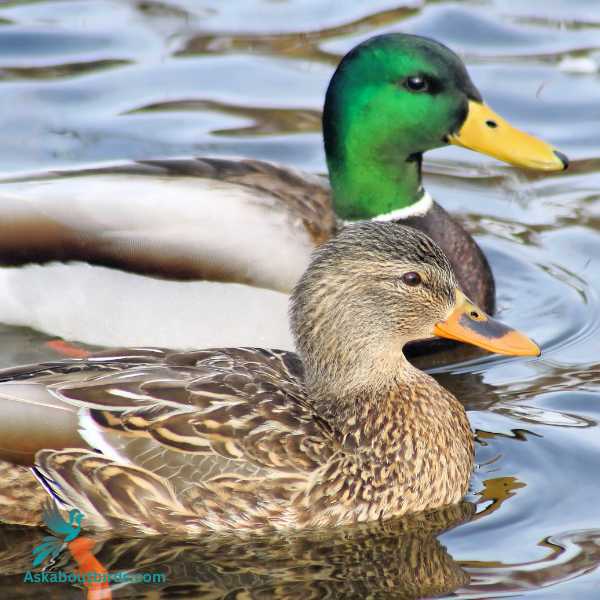
| Feature | Measurement |
|---|---|
| Scientific Name | Anas platyrhynchos |
| Length | 20-26 inches |
| Wingspan | 32-39 inches |
| Weight | 1.6-3.5 pounds |
The Mallard, one of the most recognizable of all ducks, is distinguished by its classic “quack” and its common presence in city parks and wild wetlands.
Appearance: Mallards are large ducks with a hefty body and rounded head. The male is notable for its glossy green head, gray body, and black tail-curl, while the female is mottled brown with an orange-brown bill. Both sexes have a white-bordered, blue “speculum” patch in the wing.
Diet: Mallards are omnivorous, dabbling ducks that eat a wide variety of foods. They are known to feed on aquatic vegetation, insects, worms, and grains. In city parks, they are often seen eating bread, popcorn, and other food provided by humans, although such items are not part of their natural diet.
Reproduction: Mallards nest on the ground on dry land that is close to water, under cover of tall grass or other vegetation. The female typically lays around 8 to 13 eggs and incubates them herself.
Birds That Look Remarkably Like Ducks
Here are some bird species that can appear remarkably similar to ducks:
Pied-billed grebe
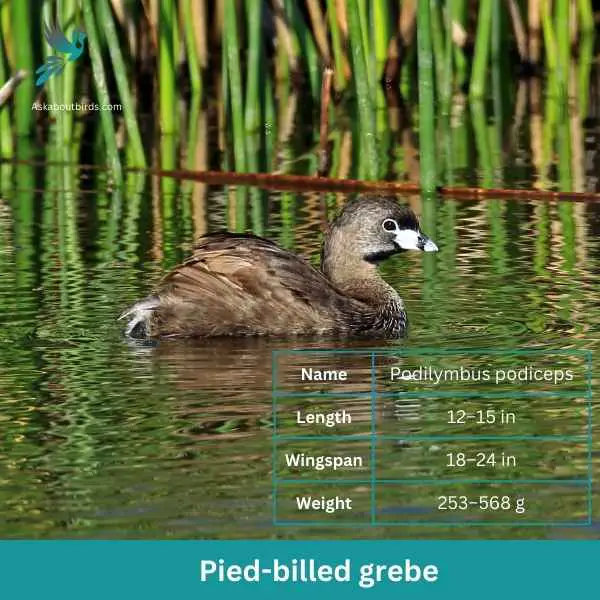
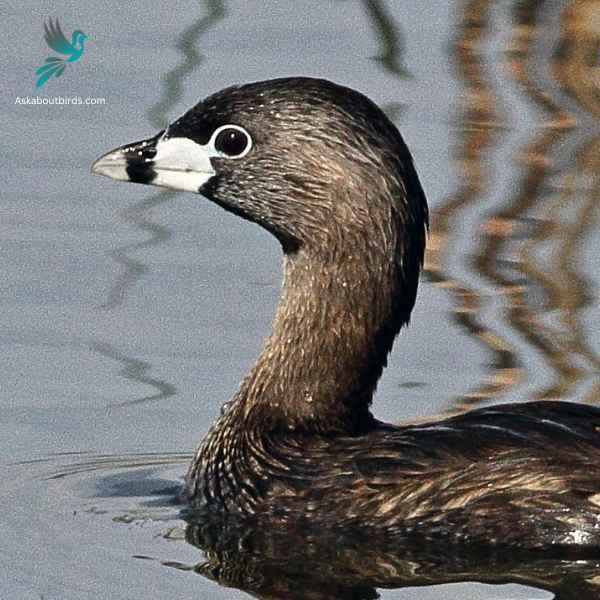
| Feature | Measurement |
|---|---|
| Scientific Name | Podilymbus podiceps |
| Length | 12.2-15 in |
| Wingspan | 17.7-24.4 in |
| Weight | 253-568 g |
The Pied-billed Grebe (Podilymbus podiceps) is a small, compact waterbird found across the Americas. Notable for its stout and short bill that features a prominent black ring during the breeding season, it gives this bird its name, “pied-billed”. Their plumage is primarily brown, helping them blend well with the marshy habitats where they’re commonly found. Unlike most birds, they have lobed, not webbed, feet situated far back on their bodies, making them excellent swimmers and divers but causing them to be awkward on land.
Pied-billed Grebes are inhabitants of freshwater wetlands, marshes, or any open body of water with dense vegetation. Their diet primarily consists of aquatic insects, crustaceans, small fish, and occasionally vegetation. Intriguingly, they build floating nests anchored to standing vegetation in their aquatic habitats. While the Pied-billed Grebe’s wide range and large population make it currently secure, it does face threats such as habitat destruction, water pollution, and sometimes hunting. Conservation strategies are primarily aimed at preserving their preferred wetland habitats and improving water quality.
Similarities
- Compact body and relatively small size can resemble a duck at a distance.
- Both have relatively short tails that are often hidden.
Differences
- Distinguished by its stout bill marked with a black band (or ring), unlike a duck’s flat bill.
- Less colorful than most ducks, mostly brownish-gray in color.
American coot


| Feature | Measurement |
|---|---|
| Scientific Name | Fulica americana |
| Length | 13.4-16.9 in |
| Wingspan | 2.8-28 in |
| Weight | 576-848 g |
The American Coot is a water bird frequently mistaken for a duck, although it’s more closely related to the rail and crane families. They are often seen on freshwater ponds and marshes across North America.
Appearance: The American Coot exhibits a slate-gray body with a white beak and a red eye. Their legs are yellow-green, and they have distinctive lobed toes instead of webbed feet, which are especially noticeable when they walk on land.
Diet: Their diet is diverse, mainly consisting of aquatic plants. They also consume insects, small fish, and other aquatic animals.
Reproduction: American Coots build floating nests anchored to aquatic vegetation in freshwater wetlands. The female typically lays a clutch of 8 to 12 eggs, which are pale with brown specks. Both parents share the responsibility of incubation and care for the chicks.
Similarities
- Comparable in size to many duck species.
- Rounded body silhouette can resemble a duck when swimming.
Differences
- Distinctive white bill and forehead shield contrast with a duck’s bill.
- Has lobed toes instead of the webbed feet seen in ducks.
Brant
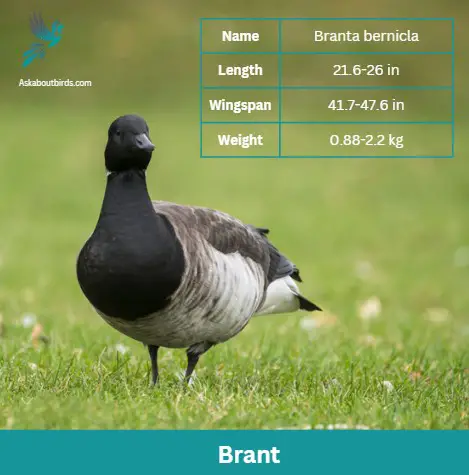

| Feature | Measurement |
|---|---|
| Scientific Name | Branta bernicla |
| Length | 21.6-26 in |
| Wingspan | 41.7-47.6 in |
| Weight | 0.88-2.2 kg |
The Brant (Branta bernicla), also known as the Brent Goose, is a small, sea-dwelling goose species native to the Arctic region. Distinguished by its dark brown or black body, short, stubby bill, and a patch of white on its neck, the Brant is less sociable compared to other geese, typically forming small flocks. It’s often observed in coastal areas, where it feeds and rests during high tide. The Brant’s flight is swift and direct, displaying a beautiful spectacle of shifting formations.
In their Arctic breeding grounds, Brants consume a diet of leaves, stems, and roots of grasses and sedges. However, during winter or migration along the coasts, their diet shifts dramatically to include eelgrass and sea lettuce, showcasing their ability to adapt to different habitats. Brants face threats from habitat loss, disturbance, and changes in food availability due to the effects of climate change on their Arctic breeding grounds. Therefore, conservation efforts aim to protect these critical habitats and monitor population trends to ensure the survival of this species.
Similarities
- Similar in size and shape to some duck species.
- Both have short tails and strong wings.
Differences
- Darker plumage, less varied than the multicolored mallard.
- Shows a small, stubby bill compared to the broader bill of a duck.
Double-crested cormorant


| Feature | Measurement |
|---|---|
| Scientific Name | Nannopterum auritum |
| Length | 28–35 in |
| Wingspan | 45–48 in |
| Weight | 1.2–2.5 kg |
The Double-Crested Cormorant (Phalacrocorax auritus) is a large waterbird known for its long neck, hooked bill, and almost entirely black body. The species gets its name from the two small patches of tufted feathers or “crests” found on the heads of breeding adults, one on each side. These birds are strong swimmers that propel themselves underwater with their webbed feet, their bodies submerged and necks above the water surface, giving them a characteristic snake-like appearance when swimming.
Double-Crested Cormorants are widely distributed across North America and can be found in a variety of aquatic environments including freshwater lakes, coastal areas, and rivers. Their diet primarily consists of fish, which they catch by diving from the water’s surface. Often seen perched with wings outstretched to dry after fishing, these cormorants nest in trees, on the ground, or on cliff edges, usually in colonies. While they have rebounded from decreases in the mid-20th century due to DDT-related reproductive failures, they face ongoing threats from habitat loss, entanglement in fishing gear, and conflicts with fisheries over their consumption of fish. Protection and careful management of their habitats are key to their ongoing conservation.
Similarities
- In flight or swimming, its silhouette might be mistaken for a large duck.
- Both species possess strong wings.
Differences
- Longer neck and hooked bill distinguish it from ducks.
- Holds wings out to dry, a behavior not seen in ducks.
Common moorhen

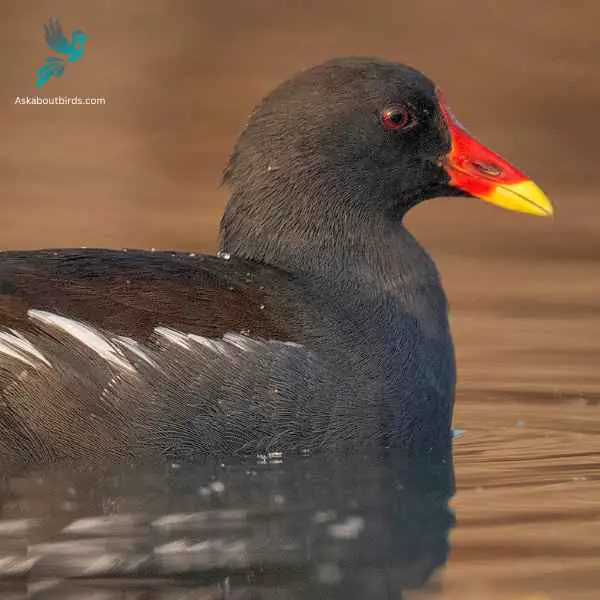
| Feature | Measurement |
|---|---|
| Scientific Name | Gallinula chloropus |
| Length | 12-15 in |
| Wingspan | 20-24 in |
| Weight | 192 to 500 g |
The Common Moorhen (Gallinula chloropus), also known as the Waterhen or the Swamp Chicken, is a bird species found in marshes, ponds, and wetlands across many parts of the world. It is medium-sized with a dark plumage, a line of white feathers along the flanks, and a red and yellow beak and frontal shield. The bird’s name comes from the Anglo-Saxon ‘mor’, meaning marsh or mere.
Common Moorhens are omnivorous birds, feeding on a diverse diet that includes seeds, leaves, fruits, insects, worms, fish, and amphibians. They are notable for their wide-ranging calls, which are often described as a repetitive, cackling ‘kruk-kruk’ sound. Their nests, built in dense vegetation and often on a raft of floating vegetation, may hold up to 8 eggs. While they are still common in many regions, the Common Moorhen faces threats that include habitat loss due to drainage of wetlands, pollution of waterways, and predation. As a result, conservation efforts are important and focus on protecting wetland habitats and maintaining water quality.
Similarities
- Comparable in size to many duck species.
- Both have rounded body shapes.
Differences
- Exhibits a distinct red and yellow bill and forehead shield.
- Shows a white line along its side, unlike ducks.
Common loon


| Feature | Measurement |
|---|---|
| Scientific Name | Gavia immer |
| Length | 26 to 36 in |
| Wingspan | 4 ft 2 in to 4 ft 10 in |
| Weight | 2.2 to 7.6 kg |
The Common Loon (Gavia immer), also known as the Great Northern Diver, is a bird of northern North American waterways, known for its striking appearance and haunting vocalizations. Adults sport a black head, white underparts, and a checkered black-and-white mantle. Their eyes are fiery red, and they have a sharp, dagger-like bill. In summer, they transform into an exquisite combination of black and white, while in winter, their plumage turns gray and white. They are powerful, agile swimmers, but their awkward gait on land is due to their legs being placed far back on their bodies.
The Common Loon prefers freshwater lakes and larger ponds but migrates to coastal waters in winter. They feed primarily on fish, which they catch by diving from the surface and pursuing their prey underwater. Their mournful, yodel-like calls are a signature sound of northern lakes. Breeding pairs are territorial and are known to reuse the same site year after year. Despite being a beloved symbol of the wilderness, the Common Loon faces threats from habitat loss, pollution, and human disturbance. Conservation efforts are underway to help protect this species and preserve its place in North American wetlands.
Similarities
- Size and streamlined body shape can resemble a duck at a distance.
- Both have strong, solid bodies.
Differences
- Pointed bill, often held pointing slightly upwards, differs from a duck’s bill.
- Striking black and white plumage in summer is unlike most ducks.
Western Grebe


| Feature | Measurement |
|---|---|
| Scientific Name | Aechmophorus occidentalis |
| Length | 22–30 in |
| Wingspan | 31–40 in |
| Weight | 1.753–4.409 lb |
The Western Grebe (Aechmophorus occidentalis) is the largest North American grebe, best known for its elegant appearance and intricate mating dances. Recognizable by its long, slender neck, sharp black-and-white coloration, and bright red eyes, it stands out in its predominantly aquatic habitat. Males and females look alike, both possessing the same striking dark above and white below contrast, with a distinctive black cap running below the eye.
Western Grebes are found in large lakes and coastal saltwater habitats during the non-breeding season. They are remarkable swimmers and divers, primarily feeding on fish, which they catch with rapid thrusts of their dagger-like beaks. The species is famous for its courtship ritual known as “rushing,” where two birds turn to one side, lunge forward in synchrony, their bodies completely out of the water, and race across the water side by side, creating a truly unique spectacle. Despite being widespread and fairly common, the Western Grebe populations have declined in some areas due to habitat loss, pollution, and entanglement in fishing gear.
Similarities
- Long body in water might resemble a duck at a glance.
- Both species have relatively short tails.
Differences
- Long neck and pointed bill distinguish it from ducks.
- Displays a contrasting black-and-white color pattern.
Red-necked Grebe
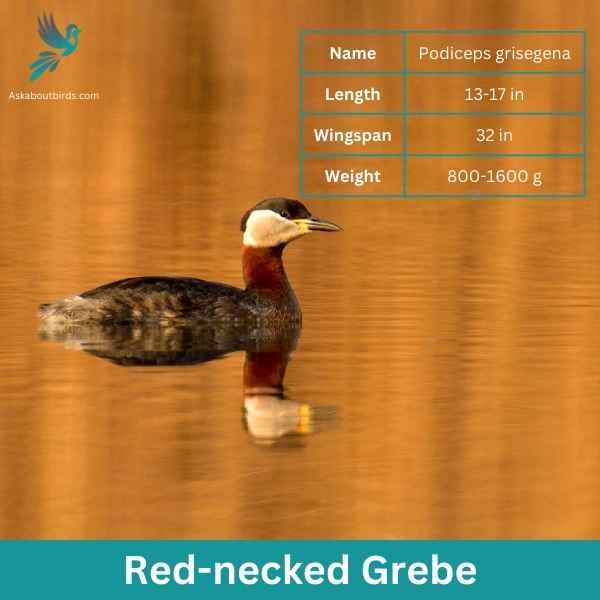
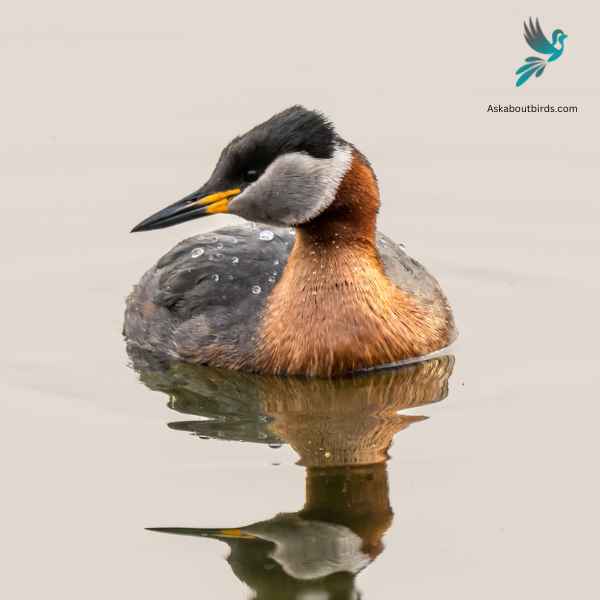
| Feature | Measurement |
|---|---|
| Scientific Name | Podiceps grisegena |
| Length | 13-17 inches |
| Wingspan | 32 inches |
| Weight | 800-1600 grams |
The Red-necked Grebe (Podiceps grisegena) is a striking waterbird known for its distinctive appearance and exceptional diving abilities.
Appearance: During the breeding season, these medium-sized grebes display a vibrant combination of colors, with a captivating red neck and a sleek black cap atop their heads. The rest of their plumage features shades of gray, complemented by a white facial patch and striking red eyes. With their pointed bills and lobed feet.
Diet: Inhabiting a wide range of freshwater environments such as marshes, ponds, and lakes, Red-necked Grebes are opportunistic carnivores with a diverse diet. Their menu consists of small fish, aquatic invertebrates, and occasional amphibians, and they might even consume some plant material.
Reproduction: During the breeding season, they construct floating nests anchored to vegetation or debris, where the female lays a clutch of 3 to 5 eggs. Both parents actively participate in incubating the eggs and raising the downy, precocious chicks, showcasing their dedicated parental care. Though not globally threatened, local populations can be at risk due to habitat loss and human disturbances to their breeding sites.
Similarities
- Rounded body shape and size can resemble a large duck when seen at a distance.
- Both have sturdy bodies and strong wings.
Differences
- Long neck and pointed bill distinguish it from ducks.
- Its reddish neck during breeding season differs from duck coloring.
Eared Grebe


| Feature | Measurement |
|---|---|
| Scientific Name | Podiceps nigricollis |
| Length | 10-13 inches |
| Wingspan | 16-20 inches |
| Weight | 200-500 grams |
The Eared Grebe (Podiceps nigricollis) is a small, water-dwelling bird species found primarily in North America, parts of South America, and some regions of Europe and Asia.
Appearance: During the breeding season, adults have a striking black cap on the crown of their heads, which contrasts with their white cheeks and neck. The rest of their plumage is mainly gray with a slight reddish-brown hue on the neck and sides during this period. They have a distinctive red eye, which adds to their overall appearance. Outside of the breeding season, their plumage becomes more subdued, with less contrast and a grayer appearance.
Diet: The diet of Eared Grebes (Podiceps nigricollis) mainly consists of small aquatic invertebrates, fish, and plant matter. As highly skilled divers, they forage for food underwater, using their lobed toes to propel themselves effectively through the water.
Reproduction: Eared Grebes construct floating nests made of plant materials anchored to emergent vegetation near the water’s edge. They are colonial nesters, often forming large colonies with other waterbirds.
Similarities
- Compact, rounded body might resemble a duck when swimming.
- Similar size to many duck species.
Differences
- Displays distinctive tufts of feathers (‘ears’) behind the eyes in breeding season.
- Dark in color with a sharp, pointed bill, unlike most ducks.
Black-necked Grebe

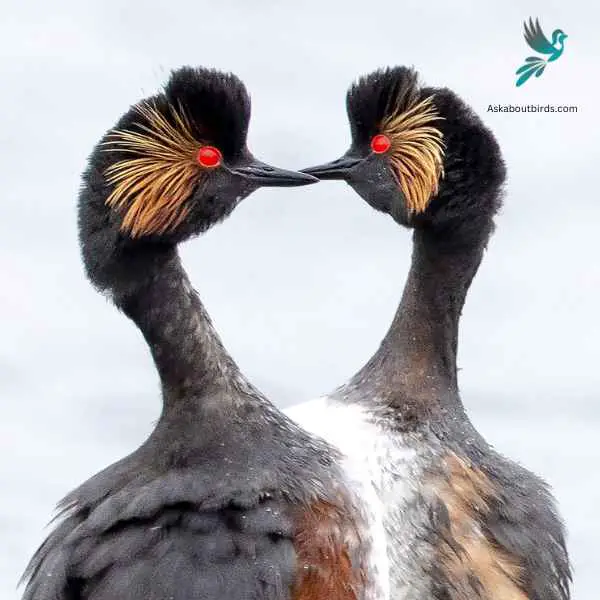
| Feature | Measurement |
|---|---|
| Scientific Name | Podiceps nigricollis |
| Length | 10-13 inches |
| Wingspan | 16-20 inches |
| Weight | 200-500 grams |
The Black-necked Grebe (Podiceps nigricollis) is a small waterbird belonging to the grebe family, found in various freshwater and brackish water habitats across Europe, Asia, and parts of Africa.
Appearance: The Black-necked Grebe is a striking bird with distinct breeding and non-breeding plumages. During the breeding season, adult Black-necked Grebes have a striking appearance, with a black crown and nape that extends down the back of their neck, contrasting with their creamy-white face and throat. Their cheeks are dark, and their sides are chestnut-brown. They have red eyes and a thin, slightly upturned bill. The rest of their plumage is predominantly black.
Diet: They are highly skilled divers and swimmers, capable of remaining submerged for extended periods while foraging for small aquatic prey. Their diet primarily consists of small fish, aquatic invertebrates, and aquatic vegetation.
Reproduction: Black-necked Grebes are solitary birds outside of the breeding season, although they may gather in loose groups or small flocks during migration or in areas with abundant food resources. During the breeding season, pairs form and build floating nests in dense vegetation near the water’s edge. The nest is a floating platform made of aquatic vegetation, anchored to emergent plants.
Similarities
- Rounded body shape can resemble a duck when swimming.
- Similar size to many duck species.
Differences
- Black neck and pointed bill contrast with duck features.
- Shows bright red eyes, unlike most ducks.
Horned Grebe
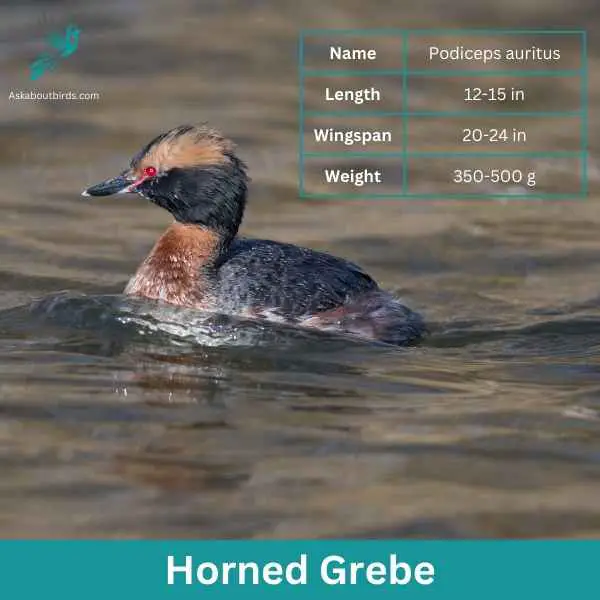

| Feature | Measurement |
|---|---|
| Scientific Name | Podiceps auritus |
| Length | 12-15 inches |
| Wingspan | 20-24 inches |
| Weight | 350-500 grams |
The Horned Grebe (Podiceps auritus), also known as the Slavonian Grebe, is a small waterbird species found in North America, Europe, and parts of Asia. It is known for its striking breeding plumage and distinctively “horned” golden tufts of feathers behind its eyes.
Appearance: During the breeding season, the Horned Grebe displays vibrant and eye-catching plumage. Its head and neck are mostly black, with a white patch on the face just below the eye. The most distinctive feature is the golden “horns” or tufts of feathers that extend back from the eyes, giving the bird its common name. The upperparts are mainly black, while the underparts are white.
Diet: Their diet consists mainly of small fish, aquatic invertebrates, and some plant matter. During the breeding season, Horned Grebes build floating nests made of aquatic vegetation, anchored to submerged plants or emergent vegetation near the water’s edge.
Reproduction: The female lays a clutch of several eggs, and both parents take turns incubating the eggs and caring for the chicks. After hatching, the chicks ride on their parents’ backs to stay safe and warm.
Similarities
- Similar size to many ducks.
- Rounded body shape can resemble a duck when swimming.
Differences
- Displays ‘horns’ of feathers in breeding season, unlike ducks.
- Reddish neck and dark back contrast with typical duck coloring.
FAQS on Duck Like Birds
What bird looks similar to a duck?
The American Coot (often called a mud hen) often looks similar to a duck due to its comparable size and the fact that it is often found in the same aquatic habitats. However, unlike ducks, coots have a white bill and chicken-like feet, lacking the webbing found in duck species.
What is a small water bird that looks like a duck?
The Grebe are small aquatic birds that can easily be mistaken for a duck. With its compact, streamlined body, short tail, and pointed bill, it shares many physical characteristics with ducks, but grebes display a distinct diving and swimming behavior.
What bird looks like a duck but bigger?
The Canada Goose (which are migratory birds) can often be mistaken for a larger version of a duck. It shares a similar body shape and aquatic habitat with ducks, but the Canada Goose is larger and has a distinctive black head and neck with a white chinstrap marking. Alternatively a brown pelican (that eats yellow perch) can often be mistaken for diving ducks.
What other bird looks like a coot?
The Gallinule, specifically the Common Gallinule, often looks similar to a Coot. Like the Coot, the Common Gallinule has a ‘duck-like’ appearance and is found in wetland habitats. However, Gallinules are distinct with their red and yellow bill and a line of yellow along the leg.
What is the difference between a dabbling duck and a diving duck?
Dabbling ducks, often referred to as “puddle ducks,” feed primarily at the water’s surface or by tipping forward to reach slightly below. Notably, they have a light body structure which allows immediate takeoff from the water. In contrast, diving ducks submerge completely underwater to forage, their diet often includes fish and shellfish. Due to their heavier bodies, they require a running start for takeoff.
What is a migratory bird that look like ducks along the Pacific Coast?
Some migratory birds that resemble ducks along the Pacific Coast include the Pied-billed Grebe, the American Coot, and the Common Loon. Each of these species has certain features that may lead observers to mistake them for ducks.




